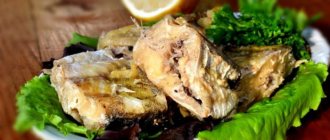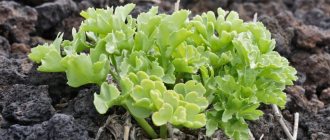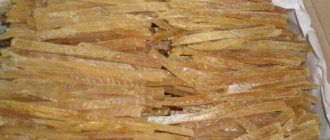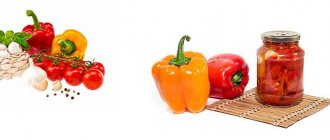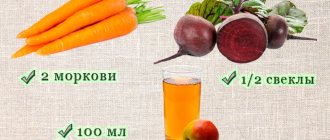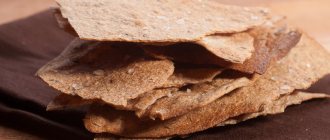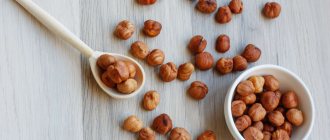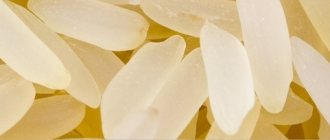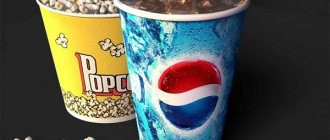KBZHU
For those who are trying to keep themselves in good shape or are at the stage of losing weight, it is necessary to know how many calories, proteins, fats and carbohydrates are contained in cabbage from the sea. The ratio of these indicators in the product is called KBJU.
It is also necessary for people to calculate KBZHU when gaining weight and maintaining it. Calorie content, protein, fat, carbohydrate content (BJU) in kelp are given in the following table:
| Index | Unit | Quantity per 100 grams of product | % of standard value |
| Calories | Kcal | 24,9 | 1,6 |
| Squirrels | G | 0,9 | 1 |
| Fats | G | 0,2 | 0,3 |
| Carbohydrates | G | 3 | 2,1 |
| Water | G | 88 | 3,2 |
| Alimentary fiber | G | 0,6 | 3 |
Calorie content of seaweed in different cooking methods
The calorie content of fresh seaweed is 5.4 kcal/100 g. This is three times less than the calorie content of a cucumber.
The calorie content of canned seaweed is also quite modest - only 6 kilocalories per 100 grams. It goes well with vegetables, mushrooms, meat and seafood.
Seaweed with oil and vinegar contains 30-55 kcal/100 g. Not much either. It is best to choose olive oil for vinegar-oil filling - healthy and low-calorie.
Korean marinated kelp with carrots contains an average of 55-60 kcal/100 g. Marinated kelp itself, seasoned with olive oil, is considered a dietary dish, but adding additional ingredients increases the energy value.
The calorie content of dry seaweed is 450-470 kcal/100 g. You should not be afraid of this large figure; it is hardly possible to eat so much at one time. Dry kelp can be used as a seasoning for soups and salads.
Calorie content per 100 grams
Algae are sold in fresh, dried, pickled and canned forms. But the calorie content of seaweed in any form remains low. The manufacturer indicates exact data on the energy value and ratio of BJU on the packaging or label. The calorie content of sea ginseng varies depending on the method of its preparation.
How often do you eat seaweed?
- Once a month 39%, 611 votes
611 votes 39%611 votes - 39% of all votes
- Once a week 25%, 398 votes
398 votes 25%
398 votes - 25% of all votes
- Every day 21%, 339 votes
339 votes 21%
339 votes - 21% of all votes
- I don’t eat at all 15%, 238 votes
238 votes 15%
238 votes - 15% of all votes
Total votes: 1586
23.09.2019
- Once a month 39%, 611 votes
611 votes 39%611 votes - 39% of all votes
- Once a week 25%, 398 votes
398 votes 25%
398 votes - 25% of all votes
- Every day 21%, 339 votes
339 votes 21%
339 votes - 21% of all votes
- I don’t eat at all 15%, 238 votes
238 votes 15%
238 votes - 15% of all votes
Total votes: 1586
23.09.2019
×
You or from your IP have already voted.
The table shows how many kcal are contained in 100 g of seaweed in its different states:
| Product Status | Energy value |
| Fresh | 25 kcal |
| In a canned or pickled product | 50 kcal |
| Dried | 350 kcal |
| Cooked in Korean style | 80 kcal |
| In mayonnaise filling | 176 kcal |
Attention! Cabbage grown at sea, when vegetable oil is added to dishes with it, is higher in calories. People using algae for dietary nutrition need to remember this.
The benefits of kelp
Is pickled seaweed healthy? Of course yes. At the moment, scientists continue to discover new beneficial properties of kelp, which leads to an increase in demand for such a useful product.
Sea kale, also known as kelp, is widely used not only as a food product, but also in medicine and cosmetology.
Numerous vitamins and elements of seaweed give it a number of beneficial qualities.:
The iodine contained in kelp is not destroyed during any heat treatment, which allows a person to obtain a sufficient amount of this element for his life without worrying about the method of its preparation.- Eating seaweed prevents atherosclerosis and blood clots.
- Being a kind of “cleaner” for blood vessels, it does not allow cholesterol to accumulate on their walls.
- Laminaria normalizes metabolic processes and replenishes and maintains the necessary water balance in the body.
During the diet, it is necessary to avoid pickled seaweed , since the spices used in the marinade may have a negative effect on obtaining the desired effect.
Contraindications for use
Important! In addition to the obvious benefits, pickled seaweed can also cause harm to health.
Having many vitamins and mineral elements in its composition, kelp has a number of contraindications for certain groups of people, namely :
- People who are allergic, intolerant or hypersensitive to iodine are strictly prohibited from consuming such a product.
- Laminaria should not be included in the diet of a child under 3 years of age.
- Pregnant women should exclude or minimize the intake of seaweed in their diet, since the iodine in its composition can cause abnormalities in the fetus.
- Those suffering from furunculosis, as well as people with kidney diseases, are not recommended to consume seaweed.
When choosing seaweed, pay attention to where it came from, or rather where it grew . This plant is capable of absorbing from its environment (sea water) not only useful, but also harmful substances, and if the place of growth was in polluted waters, it is better not to consume such cabbage.
We bring to your attention recipes for making pickled cabbage: with beets in Georgian style, in Gurian style, with turmeric, in a hot marinade, with bell pepper or chili, in Korean, with garlic, pieces, with carrots and other vegetables.
Is kelp a protein or a carbohydrate?
Approximately 59% of sea ginseng is carbohydrates, which turns it into a complete source of energy necessary for humans. Therefore, many people think that cabbage grown in the depths of the sea is high in calories. This is misleading because it contains very few calories.
Proteins make up 13% of brown algae. Cabbage from the sea contains well-balanced proteins that help normalize biological processes within the body.
The minimal fat content allows the use of marine ginseng in dietary nutrition.
What is the nutritional value of seaweed?
The nutritional value of kelp lies in its rich chemical composition. Despite the small amount of nutrients, algae contains numerous minerals and a whole complex of vitamins.
The product contains vitamins A, C, D, E and B vitamins.
The chemical composition of seaweed includes a wide range of micro- and macroelements. It is recommended for consumption due to its high content of iodine, potassium, calcium, magnesium, sodium, iron and phosphorus.
Eating approximately 50 g of brown algae per day can provide the body with the daily requirement of most of the nutrients necessary for its normal functioning.
Medicinal properties of seaweed
The medicinal properties of seaweed are used in folk medicine for various diseases. Let's look at the most common methods of application:
- Sea kale is used to cleanse blood vessels in the treatment of atherosclerosis. The recipe is extremely simple: you need to add half a small spoon of kelp powder to any meal for 2-3 weeks.
- The product is used to cleanse the skin of poisons and give it elasticity. To achieve the desired effect, you need to pour 100 g of dry algae into 1 liter of water and hold for an hour, and then pour the tincture into a bath of warm water (approximately 38-39 degrees). It is necessary to take water procedures within 10 minutes.
- Algae are used to prevent hypothyroidism. To do this, you need to include a couple of teaspoons of dry seaweed in your diet every day or eat 250-300 g of canned kelp per day.
Dry powder can not only be added as a seasoning to dishes, but also mixed with water for drinking.
© MASAFUMI — stock.adobe.com
Benefits for the body
Thanks to its rich chemical composition with a large number of vitamins, micro- and macroelements, kelp has many beneficial properties for humans:
- Normalizes thyroid function, replenishing iodine deficiency.
- Strengthens hair, rejuvenates facial skin and improves its color.
- Prevents thrombosis and the development of atherosclerosis.
- Normalizes the functioning of the gastrointestinal tract. Helps with constipation because it has a laxative effect.
- It is a good preventative against cancer.
- Neutralizes harm from radionuclides, heavy metals and toxins.
- It has a beneficial effect on the functioning of the circulatory system and reproductive ability.
- Helps increase hemoglobin.
For women
When consuming cabbage grown in the sea, women reduce the risk of the occurrence and further development of malignant tumors in the mammary glands. It is useful for women's health because it provides:
- Bringing the menstrual cycle back to normal,
- Preparing the body for pregnancy
- Restoration of hormonal levels.
Attention! During pregnancy, sea ginseng should be used with caution, as an allergic reaction may occur. You need to consult a doctor.
Marine ginseng is actively used in the cosmetics industry. It is used for anti-cellulite wraps and is a component of masks and creams for hair and facial skin. Algae-based products have a tonic and rejuvenating effect.
For men
Since cabbage from the deep sea is a natural aphrodisiac, its consumption can increase sexual desire. It has the following effects on the male body:
- Promotes testosterone production
- Reduces the risk of prostate cancer,
- Prevents erectile dysfunction,
- Increases sperm motility.
The beneficial characteristics of the product appear in men even when consuming a small amount.
For those losing weight
Laminaria is a dietary product that promotes weight loss. Thanks to the preservation of beneficial microelements and vitamins, it is useful for the health of the entire body.
For those who decide to lose weight, the benefits of algae are as follows:
- Acceleration of metabolic processes,
- Saturation of the body for a long time,
- Removing excess fluid from the body,
- Removal of toxic substances and waste.
Is there any harm to the body?
It is believed that kelp is absolutely harmless, but still seaweed, consumed in large quantities, can cause quite serious harm. The high iodine content makes this brown algae unique and emphasizes its beneficial properties. However, this element is unacceptable for some consumer groups.
Iodine is contraindicated in pregnant women, since its accumulation in the placenta negatively affects the development of the fetus. The accumulation of this element in the mammary gland makes seaweed unacceptable for consumption by nursing mothers.
Likewise, due to its diverse chemical composition, kelp is harmful because it can worsen the course of certain diseases:
- Allergic (possible development of urticaria).
- Hyperfunction of the thyroid gland (Exceeding the norm of iodine has a negative effect on the organ).
- Nephritis (High calcium content leads to the growth of calcifications).
- Acne (hormonal imbalance).
- Furunculosis.
With disproportionate consumption of kelp, osteoporosis and iodism are possible.
In addition, the harm of seaweed may depend on the method of preparation. In canned form, kelp retains almost all of its elements that make it useful. However, the preparation uses E220, a preservative that has a negative effect on the kidneys. They are also negatively affected by a large amount of salt, which is necessarily present during preservation.
When consuming pickled kelp, you can forget about losing weight. This is due to the variety of spices used in the product. Marinades are contraindicated for people with high stomach acidity, as they cause flatulence.
And the main harm of sea kale is hidden in the high content of alginates. Brown algae has powerful absorption properties. If kelp was brought from “unclean” areas, then you can expect anything.
Harm
When consuming kelp, it is important to adhere to the permissible dosage in order to avoid its negative effects on the body.
- Algae are contraindicated for people with increased thyroid function, when the concentration of iodine in the body is excessive.
- Cabbage grown in areas with poor ecology can cause heavy metal poisoning. This is due to the plant’s ability to absorb toxic substances.
- It is worth avoiding the use of sea ginseng if you have existing kidney pathologies.
- If you have acne on your skin, you should also avoid eating seaweed.
- Algae are prohibited for tuberculosis, urticaria and furunculosis.
- It is not recommended to use kelp if you have diseases of the gastrointestinal tract.
Attention! During lactation, kelp should be used with caution. First, it is eaten in small portions, observing how the child’s body reacts to the new product.
How to select and store seaweed?
You can choose any type of useful product for yourself. After collection, the kelp is immediately heat-treated to remove excess moisture. If there is a lot of water in the product, it will quickly spoil.
If you decide to buy seaweed, pay attention to the following features:
- When purchasing dried cabbage, carefully inspect the leaves. There should be no traces of mold on them. If you press on the plant, it should not fall apart. Choose kelp with a smooth surface, the leaves of which do not stick together;
- If you buy canned cabbage, it is already packaged in plastic containers. Carefully study the composition so that it does not contain preservatives;
- Keep an eye on expiration dates;
- Buy kelp with green leaves. The pigment should be uniform over the entire surface of the sea plant. The optimal sheet thickness is at least 1.5 mm.
If the leaves are brown, it means the product is not yet ripe. You are allowed to eat it, but there will be a minimal amount of nutritional components in the composition. Choose products in transparent and solid packaging. This way you will be sure that it is not spoiled.
- You should choose seaweed without foreign objects. Quite often, during collection, sand, mesh elements, etc. get inside. If condensation forms on the packaging, it means the product has deteriorated. Consuming it is dangerous to health.
There is no need to buy kelp that smells too much like vinegar. It is used to remove foreign odors, such as mold. If there are pieces of ice on the package, it means it has been frozen several times and has lost some of its nutrients.
- Only fresh varieties that have not undergone the fermentation process are allowed to be placed in the freezer. If you bought dried kelp, first boil it, place it in the refrigerator for a day, and then put it in the freezer.
- It can be packaged in bags, plastic containers or foil. Freeze the product in small portions so that you do not have to freeze it several times.
- The optimal shelf life in the freezer is no more than 30 days. Defrosting should be carried out at room temperature. If you want to speed up the process, place the sealed container in warm water.
- If you bought dried kelp in sealed packaging in a store, its shelf life is about 3 years.
- After opening the package, the product can be stored for 30-90 days, after which it becomes hazardous to health.
- If you place the unsealed packaging in the refrigerator, the sea kale will be stored for no longer than 2 days.
Dried has a longer shelf life.
As you can see, kelp is a dietary product that brings many benefits to the body. Regular consumption can prevent many dangerous diseases. The main thing is to use the product only after consulting a doctor, so as not to harm your body.
We will also talk about calorie content:
- Vinaigrette
- Buckwheat
- Pumpkins
- Guilt
- Spinach
Does kelp contain Omega 3?
Seaweed contains large quantities of Omega-3 and Omega-6 polyunsaturated fatty acids, which prevent the development of atherosclerosis. Eating a small amount of brown algae every day can prevent heart attacks, strengthen blood vessels and reduce cholesterol in the blood. Daily consumption helps fight hypertension.
The human body is not capable of producing polyunsaturated fatty acids, so it is necessary to obtain them through foods containing them. Therefore, if there is a shortage of these substances, it is recommended to include dishes with sea ginseng in your diet every day.
Chemical composition of kelp
Laminaria is a real storehouse of minerals. Sea kale does not contain too many vitamins, but in terms of the content of some microelements, no other product can compare with it.
For clarity, we have placed the substances and their concentrations in separate tables. Be sure to look into them: a small amount of kelp will help you avoid taking additional dietary supplements. The numbers in the chemical composition are relevant for pickled seaweed; the concentration of nutrients in other dishes with kelp may differ slightly.
Table 2 - Content of vitamins per 100 g of product
| Vitamin name | Concentration in mg | % of daily value |
| B5 (pantothenic acid) | 0,6 | 13 |
| B2 (riboflavin) | 0,15–0,32 | 12 |
| C (ascorbic acid) | 3–10 | 9 |
| B1 (thiamine) | 0,06–0,2 | 7,5 |
| E (tocopherol) | 0,9 | 6 |
| PP (nicotinic acid) | 0,47–1,5 | 5 |
| Kholin | 6–12,8 | 2 |
| Concentration in mcg | ||
| K (phylloquinone) | 66 | 55 |
| D (ergocalciferol) | 2,5 | 48 |
| B9 (folic acid) | 180 | 45 |
| B12 (cyanocobalamin) | 1 | 33 |
| Biotin | 3 | 6 |
| A (beta-carotene) | 64–336 | 4 |
| Lutein and zeaxanthin | 62 | 1 |
| B6 (pyridoxine) | 0,01 | 0,3 |
Seaweed is an excellent source of vitamins K, D and B9. The product is also useful for vegans who receive almost no cyanocobalamin from food. This vitamin is found in meat, but vegetarians do not eat it. Kelp helps reduce the risk of B12 deficiency, which is dangerous for the human body.
Kelp is not as rich in vitamins as other plant foods, but it does have a lot of minerals. A small portion covers more than 100% of the daily requirement.
Table 3 - Mineral content per 100 g of product
| Name of micro- and macroelements | Concentration in mg | % of daily value |
| Silicon | 51 | 170 |
| Chlorine | 1055 | 46 |
| Magnesium | 120–126 | 31 |
| Sodium | 234–312 | 21 |
| Iron | 3–3,30 | 20,5 |
| Calcium | 170–220 | 17 |
| Sulfur | 135 | 13,5 |
| Phosphorus | 42 | 5,5 |
| Potassium | 90–171 | 5 |
| Concentration in mcg | ||
| Iodine | 2500–3600 | 2033 |
| Bor | 255–400 | 445 |
| Bromine | 3400–13000 | 410 |
| Vanadium | 85–160 | 307 |
| Cobalt | 15 | 150 |
| Arsenic | 7–15 | 92 |
| Strontium | 200–700 | 56 |
| Cadmium | 1,5 | 28 |
| Lithium | 7,8–31 | 20 |
| Copper | 130 | 13 |
| Zinc | 1230 | 10 |
| Fluorine | 340 | 8,5 |
| Rubidium | 6–10 | 8 |
| Manganese | 120–200 | 8 |
| Molybdenum | 1,5–9,5 | 8 |
| Titanium | 55–60 | 6,5 |
| Germanium | 25 | 6 |
| Nickel | 0,2–8 | 3 |
| Thallium | 0,04 | 2 |
| Aluminum | 580–620 | 1,5 |
| Selenium | 0,7 | 1,1 |
| Chromium | 0,5 | 1 |
Sea kale has high nutritional value. It contains a huge amount of iodine, boron and bromine. Laminaria is recommended for people with a deficiency of these minerals. But if you have an excess of these substances, seaweed with a large number of microelements should be avoided, otherwise the situation will worsen. But people living far from sea coasts usually have a deficiency, so eat kelp for health if there are no chronic diseases or contraindications.
